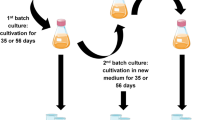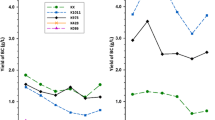Abstract
Microbial cellulose has many potential applications due to its excellent physical properties. The production of cellulose fromAcetobacter xylinum in submerged culture is, however, beset with numerous problems. The most difficult one has been the appearance of negative mutants under shaking culture conditions, which is deficient of cellulose producing ability. Thus genetic instability ofAcetobacter xylinum under shaking culture condition made developing a stable mutant major research interest in recent years. To find a proper type of bioreactor for the production of microbial cellulose, several production systems were developed. Using a reactor system with planar type impeller with bottom sparging system, it was possible to produce 5 g/L microbial cellulose without generating cellulose minus mutants, which is comparable to that of static culture system.
Similar content being viewed by others
References
Gibson, E. J. and J. R. Colvin (1968) Extension of bundles of cellulose microfibrils on agar surfaces byAcetobacter xylinum.Can. J. Microbiol. 14: 93–95.
Takai, M. (1994) Bacterial cellulose composites p. 233–240 In: R. D. Gilbert (ed.) Cellulosic Polymers, Hanser Publishers. Munich, Germany.
Ross, P., R. Mayer, and M. Benziman (1991) Cellulose biosynthesis and function in bacteria.Microbiol. Rev. 55: 35–58.
Hasegawa, M., A. Isogai, S. Kuga, and F. Onabe (1994) Preparation of cellulose-chitosan blend film using chloral/dimethylformamide.Polymer 35: 983–987.
Fontana, J. D., A. M. de Souza, C. K. Fontana, I. L. Torriani, J. C. Moreschi, B. J. Gallotti, S. J. de Souza, G. P. Narcisco, J. A. Bichara, and L. F. X. Farah (1990)Acetobacter cellulose pellicle as temporary skin substitute.Appl. Biochem. Biotechnol. 24: 253–264.
Fontana, J. D., V. C. Franco, S. J. de Souza, I. N. Lyra, and A. M. de Souza (1991) Nature of plant stimulators in the production ofAcetobacter xylinum biofilm used in skin therapy.Appl. Biochem. Biotechnol. 28: 341–351.
D. G. White and M. Brown, Jr. (1989) Cellulose and wood-chemistry and technology, 573–590, C. Schuerch (ed.), John Wiley & Sons, Inc. New York, NY.
Yamanaka, S. and K. Watanabe (1994) Application of bacterial cellulose. p. 207–215 In: R. D. Gilbert (ed.) Cellulosic Polymers, Hanser Publishers. Munich, Germany.
Byrom, D. (1988) Eur. Patent Appl. 0279506.
Cooper, D. and R. St. J. Manley (1975) Cellulose biosynthesis byAcetobacter xylinum.Biochim. Biophys. Acta 381: 97–108.
Kamide, K., Y. Matsuda, H. Iijima, and K. Okajima (1990) Effect of culture conditions of acetic acid bacteria on cellulose biosynthesis.British Polymer. J. 22: 167–171.
Dudman, W. F. (1959) Cellulose production byAcetobacter acetigenum in defined medium.J. Gen. Microbiol. 21: 327–337.
Masaoka S., T. Ohe, and Sakoda N. (1993) Production of cellulose from glucose byAcetobacter xylinum.J. Ferment. and Bioeng. 75: 18–22.
Schramm, M. and S. Hestrin (1954) Factors affecting production of cellulose at the air/liquid interface of a culture ofAcetobacter xylinum.J Gen. Microbiol. 11: 123–129.
Oikawa, T., T. Ohitori, and M. Ameyama (1995) Production of cellulose from D-arabitol byAcetobacter xylinum KU-1.Biosci. Biotechnol. Biochem. 59: 331–332.
Toyosaki, H., Y. Kojima, T. Tsuchida, K.-I. Hoshino, Y. Yamada, and F. Yoshinaga (1995) The characterization of an acetic acid bacterium useful for producing bacterial cellulose in agitation cultures.J Gen. Appl. Microbiol. 41: 307–314.
Valla, S., D. H. Coucheron, E. Fjaervik, J. Kjosbakken, H. Weinhouse, P. Ross, D. Amikam, and M. Benziman (1989) Cloning of a gene involved in cellulose biosynthesis inAcetobacter xylinum: complementation of cellulose-negative mutants by the UDPG pyrophosphorylase structural gene.Mol. Gen. Genet. 217: 26–30.
Forng, E. R., S. M. Anderson, and R. E. Cannon (1989) Synthetic medium forAcetobacter xylinum that can be used for isolation of auxotrophic mutants and study of cellulose biosynthesis.Appl. Environ. Microbiol. 55: 1317–1319.
Deasey, M. C. and A. G. Matthysse (1984) Interactions of wild-type and a cellulose-minus mutant ofAgrobacterium tumefaciens with tobacco mesophyll and tobacco tissue culture cells.The American Phytopathological Society 74: 991–994.
Okajima K., K. Kamade, and Y. Matsuda (1991) Study on change in the degree of polymerisation of bacterial cellulose prodeced byAcetobacter xylinium during its cultivation.Polymer International 25: 145–151.
Saxena, I. M., K. Kudlicka, K. Okuda, and R. M. Brown, Jr. (1994) Characterization of genes in the cellulose-synthesizing operon (acs operon) ofAcetobacter xylinium: Implications for cellulose crystallization.J. Bacteriol. 176: 5735–5752.
Brautaset, T., R. Standal, E. Fjaervik, and S. Valla (1994) Nucleotide sequence and expression analysis of theAcetobacter xylinum phosphoglucomutase geneMicrobiology 140: 1183–1188
Brown, R. M. Jr., C. H. Haigler, J. Suttie, A. R. White, and E. M. Roberts (1983) The biosynthesis and degradation of cellulose.J. Appl. Polymer Syn. 37: 33–78.
Ross, P., M. Raphael, H. Weinhouse, D. Amikam, Y. Huggirat, M. Benziman, E. de Vroom, A. Fidder, P. de Paus, L. A. J. M. Sliedregt, G. A. van der Marel, and Jacques H. van Boom (1990) The cyclic diguanylic acid regulatory system of cellulose synthesis inAcetobacter xylinum.J. Biol. Chem. 265: 18933–18943.
Coucheron, D. H. (1991) AnAcetobacter xylinum insertion sequence element associated with inactivation of cellulose production.J. Bacteriol. 173: 5723–5731.
Iversen T., R. Standal, T. Pedersen, and D. H. Coucheron, IS1032 fromAcetobacter xylinum, a new mobile insertion sequence.Plasmid 32: 46–54.
Tonouchi, N., T. Tsuchida, F. Yoshinaga, S. Horinouchi, and T. Beppu (1994) A host-vector system for a cellulose-producingAcetobacter strain.Biosci. Biotech. Biochem. 58: 1899–1901.
Tonouchi, N., N. Tahara, T. Tsuchida, F. Yoshinaga, T. Beppu, and S. Horinouchi (1995) Addition of a small amount of an endoglucanase enhances cellulose production byAcetobacter xylinum.Biosci. Biotech. Biochem. 59: 805–808.
Toyosaki, H., T. Naritomi, A. Seto, M. Matsuoka, T. Tsuchida, and F. Yoshinaga (1995) Screening of bacterial cellulose-producingAcetobacter strains suitable for agitated culture.Biosci. Biotech. Biochem. 59: 1498–1502.
Lee, H. C. and X. Zhao (1997) Synthetic medium for production of microbial cellulose under static and shaking culture conditions,Proc. APBio-ChE97, Beijing, China, 550–552.
Lee, H. C. and X. Zhao (1996) The optimal medium composition for the production of microbial cellulose byAcetobacter xylinum.Kor. J. Biotechnol. Bioeng. 11: 550–556.
Lee, H. C. and X. Zhao (1997) Effects of sucrose, Pluronic F-68 and cellulose on the production of microbial cellulose byAcetobacter xylinum ATCC 23769 under shaking flask culture conditions.Proc. APBioChE97, Beijing, China, 553–556.
Nakajima, M., M. Okumura, and T. Yoshida (1998) Effects of mass transfer on bacterial cellulose production.Proc. Yabec98, Hualien, Taiwan, 89–90.
Lee, H. C. (1996) Directional shear stress enhances the production of microbial cellulose byAcetobacter xylinum. Proc. Yabec96, Osaka, Japan, 80–81.
Author information
Authors and Affiliations
Corresponding author
Rights and permissions
About this article
Cite this article
Lee, H.C., Zhao, X. Effects of mixing conditions on the production of microbial cellulose byAcetobacter xylinum . Biotechnol. Bioprocess Eng. 4, 41–45 (1999). https://doi.org/10.1007/BF02931912
Issue Date:
DOI: https://doi.org/10.1007/BF02931912




